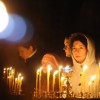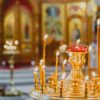In Orthodox iconography, icons depicting the Holy Leaders of the Apostles Peter and Paul best portray the very practical (and mystical!) precept that tension between Christians is superseded by unity in Christ. Different as these two Apostles were, they are most often depicted embracing or holding a church between them. The love of Christ transcends personal preferences and varieties in character. Close reading of the lives of the saints reveals many (especially among the holy hierarchs and theologians) who simply did not get along with each other. As an old priest once said to me, “We are called to love each other, not like each other.” Yet in every case, commitment to unity always supersedes personal likes and dislikes. We are the Church militant which presses forward together towards our common goal of taking the Kingdom of Heaven by force, by “violence” (Matt. 11:12). We may not like the way the soldier next to us smells, but that fact is meaningless given he is guarding our flank! “He’s got my back” is a common expression these days, but the concept is eternal.
![]()
The holy leaders of the Apostles Peter and Paul had each other’s backs. Yet their differences in personality, style, and calling were in fact so great that early heretics disputed their title as “co-leaders” of the Apostles. A heretic named Marcion believed in a radical separation between the Old and New Testaments, and between Peter and Paul. He believed that Peter represented the “Judaizing” of Christianity, while Paul represented the “pure” Gospel. The refutation of this heresy and the subsequent development of Orthodox theology regarding the nature of unity (of the Trinity, in Christ, between neighbors) resulted in part in the depiction of the Apostles Peter and Paul as embracing each other or holding between them an image of the Church. For an authentic interpretation of their relationship establishes and maintains our understanding of complete unity without loss of personal diversity.
St. Peter, the first among equals and primate of the apostles. Peter, whose natural gift was zeal without knowledge. Peter, whose boldness was ultimately his path to humility. Peter, who swore he would die with Jesus but then denied Him three times. Peter, who dove into the sea and beat the boat to the shore rather than wait patiently; Peter, whose threefold “Lord, You know all things, You know that I love You” triumphed over his previous denial and catapulted him into apostolic ministry. To him we turn when the Lord asks, “Do you love Me?”
And St. Paul: he who was supernaturally called to apostleship directly by the ascended Lord. Who boldly says of the other ministers of the Gospel, “Are they ministers of Christ? I am more.” And the affirmation of this boldness is seen in Paul’s travels, his suffering, his prolific authorship, and his unprecedented synergy of pastoral zeal with intellectual prowess. To him we turn when the Lord asks, “Do you love your neighbor?”
Together they give us the greatest example of working together and working out difficulties within the Church in a synergistic way, inspired by the Holy Spirit, that transcends the essential but more human guidelines of authority and protocol in the Church. Peter was the first of all the Apostles, yet Paul says of him, “When Peter was come to Antioch, I withstood him to the face, because he was to blame” (Gal. 2:11). The more the Church is ruled by an authentic and uncompromising dedication to true and mystically inspired unity, the more tensions within relationships, families, parishes, geographic communities, and organizational structures will be overcome. This is the synthesis of mankind’s efforts and Divine grace. The holy Apostles Peter and Paul cannot be separated although they exhibited distinct differences. “Rejoice, O Peter the Apostle, you who are the great friend of the Master, Christ our God. Rejoice, well-beloved Paul, preacher of the faith and doctor of the universe. Because of this, may you both intercede with Christ our God for the salvation of our souls.” (Vespers)
Twin lights of the Church, co-workers in the vineyard of Christ, equal in leadership and example for all, these glorious servants of Christ, Peter and Paul, were martyred on the same day in Rome, at different places. Paul, a Roman citizen, was given an “honorable” death, having his noble head cut from his body. Peter, not a citizen of Rome, was killed “dishonorably” by crucifixion. Having denied Christ and then loved Him threefold, Peter denied himself the Christlikeness of crucifixion and was voluntarily nailed to the cross upside-down.
















